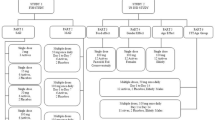Abstract
Objective
To investigate the bioavailability of rivastigmine, an approved therapy for patients with mild to moderate dementia of the Alzheimer’s type, at the highest approved single dose of 6mg.
Design and setting
Randomised, two-period crossover, single-centre, non-blinded, inpatient study.
Patients and participants
Eleven patients (five females and six males) with mean age 69.5 years.
Methods
The 6mg oral dose was compared with a 2mg intravenous dose of rivastigmine infused over a 1-hour period. Plasma concentrations of rivastigmine and its metabolite NAP 226-90 were measured with a gas chromatographic/mass spectrometric method.
Results
Following oral administration of a single 6mg capsule, rivastigmine is rapidly absorbed with an average time to peak plasma concentration of about 1 hour and an average peak concentration of about 25.6 µg/L. By a noncompartmental approach, the absolute bioavailability of the 6mg oral dose of rivastigmine was 71.7% when compared with a 2mg intravenous infusion normalised for dose. By using a population pharmacokinetic model with Michaelis-Menten elimination, absolute bioavailability was estimated at 60.2%. The average terminal elimination half-life of rivastigmine ranged from 1.4 to 1.7 hours for both treatments. Plasma concentrations of the major metabolite, NAP 226-90, formed by the hydrolysis of rivastigmine by cholinesterase are lower than those of the parent compound following oral and intravenous administration.
Conclusion
A noncompartmental approach and a compartmental approach based on a population pharmacokinetic model with Michaelis-Menten elimination yielded comparable values, 71.7% and 60.2% respectively, for the absolute bioavailability of a single 6mg oral dose of rivastigmine. Comparison with previous studies confirmed that the oral form of the drug exhibits increased bioavailability with increasing dose, consistent with its nonlinear pharmacokinetics.







Similar content being viewed by others
References
Bartus RT, Dean RL, Beer B, et al. The cholinergic hypothesis of geriatric memory dysfunction. Science 1982 Jul 30; 217: 408–17
Coyle JT, Price DL, Delong MR. Alzheimer’s disease: a disorder of cortical cholinergic innervation. Science 1983 Mar 11; 219: 1184–90
Knapp MR, Knopman DS, Solomon PR, et al. A 30-week randomized controlled trial of high-dose tacrine in patients with Alzheimer’s disease. The tacrine study group. JAMA 1994 Apr 6; 271: 985–91
Rogers SL, Doody RS, Mohs RC, et al. Donepezil improves cognitive and global function in Alzheimer’s disease. A 15-week, double-blind, placebo-controlled study. Donepezil study group. Arch Intern Med 1998 May 11; 158: 1021–31
Sramek JJ, Cutler NR. Ongoing trials in Alzheimer’s disease. Expert Opin Invest Drugs 2000; 9(4): 899–915
Rosler M, Anand R, Cicin-Sain A, et al. Efficacy and safety of rivastigmine in patients with Alzheimer’s disease: international randomised controlled trial. BMJ 1999 Mar 6; 318: 633–8
Corey-Bloom J, Anand R, Veach J. A randomized trial evaluating the efficacy and safety of ENA 713 (rivastigmine tartrate), a new acetylcholinesterase inhibitor, in patients with mild to moderately severe Alzheimer’s disease. Int J Geriatr Psychopharmacol 1998; 1: 55–65
Enz A, Amstutz R, Boddeke H, et al. Brain selective inhibition of acetylcholinesterase: a novel approach to therapy for Alzheimer’s disease. Prog Brain Res 1993; 98: 431–8
Polinsky RJ. Clinical pharmacology of rivastigmine: a new-generation acetylcholinesterase inhibitor for the treatment of Alzheimer’s disease. Clin Ther 1998 Jul–Aug; 20: 634–47
Cutler NR, Polinsky RJ, Sramek JJ, et al. Dose-dependent CSF acetylcholinesterase inhibition by SDZ ENA 713 in Alzheimer’s disease. Acta Neurol Scand 1998; 97: 244–50
Novartis, Exelon (rivastigmine tartrate) [online]. Available from URL: http://www.pharma.us.novartis.com [Accessed 2001 Jan]
Kennedy JS, Polinsky RJ, Johnson B, et al., Preferential cerebrospinal fluid acetylcholinesterase inhibition by rivastigmine in humans. J Clin Psychopharmacol 1999; 19: 513–21
Sramek JJ, Anand R, Wardle TS, et al. Safety/tolerability trial of SDZ ENA 713 in patients with probable Alzheimer’s disease. Life Sci 1996; 58: 1201–7
Cutler NR, Hartman RD, Messina J, et al. Antiemetics mitigate nausea and vomiting in Alzheimer’s patients receiving rivastigmine [abstract no. 986]. Annual Meeting of Society of Biological Psychiatry; 2000 May 11–13, Chicago
Okuma T. Differential sensitivity to the effects of psychotropic drugs: psychotics vs normals; Asians vs Western populations. Folia Psychiatr Neurol Jpn 1981; 35: 79–87
Miller AL, Maas JW, Contreras S, et al. Acute effects of neuroleptics on unmedicated schizophrenic patients and controls. Biol Psychiatry 1993; 34: 178–87
Sramek JJ, Fresquet A, Marion-Landais G, et al. Establishing the maximum tolerated dose of lesopitron in patients with generalized anxiety disorder: a bridging study. J Clin Psychopharmacol 1996; 16: 454–8
Food and Drug Administration. FDA guidance for industry: average, population, and individual approaches to establishing bioequivalence. Draft Guidance. Rockville (MD): FDA, Aug 1999
Pokorny R, Finkel MJ, Robinson WT. Normal volunteers should not be used for bioavailability or bioequivalence studies in clozapine [abstract]. Pharm Res 1994; 11: 1221
Food and Drug Administration. FDA update on clozapine guidelines. Rockville (MD): FDA, 1996
Sramek JJ, Hurley DJ, Wardle TS, et al. The safety and tolerance of xanomeline tartrate in patients with Alzheimer’s disease. J Clin Pharmacol 1995; 35: 800–6
Sramek JJ, Block GA, Reines SA, et al. A multiple-dose safety trial of eptastigmine in Alzheimer’s disease, with pharmacodynamic observations of red blood cell cholinesterase. Life Sci 1995; 56: 319–26
Imbimbo BP, Martelli P, Troetel WM, et al. Efficacy and safety of eptastigmine for the treatment of patients with Alzheimer’s disease. Neurology 1999; 52: 700–8
Puri SK, Ho I, Lassman HB. Multiple-dose pharmacokinetics, safety and tolerance of velnacrine (HP 029) in healthy elderly subjects: a potential therapeutic agent for Alzheimer’s disease. J Clin Pharmacol 1990; 30: 948–55
Cutler NR, Murphy MF, Nash RJ, et al. Clinical safety, tolerance, and plasma levels of the oral anticholinesterase 1,2,3,4-tetrahydro-9-aminoacridin-1-ol-maleate (HP 029) in Alzheimer’s disease: preliminary findings. J Clin Pharmacol 1990; 30: 556–61
Acknowledgements
The authors are grateful to Aaron Crawford, PhD, for his help in preparing this manuscript.
Author information
Authors and Affiliations
Corresponding author
Rights and permissions
About this article
Cite this article
Hossain, M., Jhee, S.S., Shiovitz, T. et al. Estimation of the Absolute Bioavailability of Rivastigmine in Patients with Mild to Moderate Dementia of the Alzheimer’s Type. Clin Pharmacokinet 41, 225–234 (2002). https://doi.org/10.2165/00003088-200241030-00006
Published:
Issue Date:
DOI: https://doi.org/10.2165/00003088-200241030-00006




